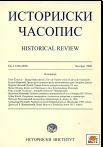Црква у Шумнику, нови поглед на датовање
The Church in Šumnik, a New Viewpoint on Dating
Author(s): Dejan BulićSubject(s): History
Published by: Istorijski institut, Beograd
Keywords: St. Nicolas – Šumnik; 14th century; Hispano-Moorish pottery; daciteandesite; St. Nicolas; Studenica; St. Nicolas Brvenik; St. Nicolas Baljevac; Radošić
Summary/Abstract: The church in Šumnik, dedicated to St. Nicolas, is situated near Raška and was once a part of Brvenik župa, although it was not mentioned in the famous document on the exchange of the property. The church was a rectangular building with semi-circular apse, dim. 11,4 m х 6,6 m. The space was divided into three unequal aisles. The smallest was the eastern one, with semi-circular niches for prothesis and diaconicon, and with one niche in the centre of the apse. The church had barrel vault with two supporting arches, placed on pilasters, with the dome placed in the centre related to the total length of the building. The local stone was used for building – yellowish sandstone, dripstone and violet dacite-andesite, with occasional secondary use of sepulchral monuments. The outer walls were plastered and decorated with wide blind arches. On the western side a porch was built later. The use of grave monuments as spolia for building the Šumnik church, the portable archaeological finds and the sepulchral monument of monk Vasilije from 14th century, as well as the position of the grave no. 5 with money of king Sigismund (1387-1437), point without any doubt to mid-14th century as the time when the church was built. Among archaeological finds the discovery of luxurious Hispano-Moorish pottery represents a true rarity, since, until today such pottery was not discovered or perhaps was not recognized on the territory of Serbia. The ground plan of the Šumnik church places it within the group of sacral buildings, erected since the third decade of the 13th century, when the church of St. Nicolas in Studenica was built, the model for most of the churches in the surrounding areas. All the other churches, with close ground plan scheme and the same project matrix, belong to the 14th century – the churches in Baljevac, Šumnik, Brvenik, Radošić and the church of St. John in Studenica. The dating was made after the mural paintings, architectural elements, sepulchral monuments, raw material and portable archaeological finds. For the moment, however, the reason for such a large number of churches dedicated to St. Nicolas in the mining area remains unknown.
Journal: Историјски часопис
- Issue Year: 2013
- Issue No: 62
- Page Range: 47-78
- Page Count: 32
- Language: Serbian

